The Chamberlain RJO101 is a wall-mounted, Wi-Fi-enabled garage door opener designed for sectional doors with torsion bars, offering a space-saving and ultra-quiet operation solution.
1.1 Overview of the RJO101 Wall Mount Garage Door Opener
The Chamberlain RJO101 is a wall-mounted, Wi-Fi-enabled garage door opener designed for sectional doors with torsion bar systems. It offers a space-saving design, eliminating the need for an overhead rail, and operates quietly. The opener is compatible with sectional doors and features a robust motor with a limited lifetime warranty. It includes a battery backup for uninterrupted operation during power outages. The RJO101 also supports smart home integration, allowing users to control and monitor their garage door remotely via Wi-Fi connectivity.
1.2 Key Features and Benefits
The RJO101 Wall Mount Garage Door Opener offers a space-saving design, eliminating the need for an overhead rail and freeing up ceiling space. Its Wi-Fi connectivity enables smart home integration, allowing remote control and monitoring. The opener features a quiet operation, perfect for homes with living spaces near the garage. A battery backup ensures functionality during power outages, and its wall-mounted design reduces noise and vibrations. The RJO101 also comes with a limited lifetime motor warranty, providing long-term reliability and peace of mind for users.
Pre-Installation Requirements
Ensure the garage door has a torsion bar system and sectional design. An electric outlet must be accessible within a 6-foot diameter of the installation area, rated for 120 VAC/60 Hz. Only trained professionals should perform the installation to guarantee safety and proper functionality.
2.1 System Compatibility and Door Type
The RJO101 is exclusively compatible with sectional garage doors equipped with torsion bar assemblies. It is not suitable for overhead setups or doors with extension springs. Designed for residential use, the opener must be installed on doors with compatible drum sizes and torsion systems; Ensure the door type matches the specifications outlined in the manual to guarantee proper functionality and safety. Incorrect installation on incompatible systems may lead to operational issues or safety hazards. Always verify door compatibility before proceeding with the installation process.
2.2 Tools and Materials Needed
To successfully install the RJO101, gather the following tools and materials: a ladder, drill, pliers, screwdrivers (Phillips and flathead), wrenches, torque wrench, socket wrench, measuring tape, level, wire cutters, and screw anchors. Additionally, ensure you have the provided hardware, such as wall brackets, torsion bar adapters, and screws. Safety equipment like gloves and safety glasses is also essential. These tools are necessary for a proper and safe installation, as outlined in Chamberlain’s guidelines for the RJO101 model.
2.3 Safety Precautions
Before starting the installation, ensure the garage door is secure and disconnected from the opener. Wear protective gear like gloves and safety glasses. Avoid using improvised tools, as they may damage components or cause injury. Ensure proper ventilation and keep children and pets away. If unsure about any step, consult a trained technician. Always follow the manufacturer’s instructions carefully to avoid accidents and ensure a safe installation process for the Chamberlain RJO101 garage door opener.

Installation Process
The Chamberlain RJO101 installation involves assembling components, mounting the opener on the wall, and connecting it to the torsion bar, followed by Wi-Fi setup and final adjustments.
3.1 Assembling the RJO101 Opener
Assembling the RJO101 begins with unpacking and organizing all components. Attach the motor unit to the mounting bracket, ensuring proper alignment. Use the provided hardware to secure connections. Next, install the belt or chain, following the manual’s tensioning guidelines. Ensure all moving parts are lubricated for smooth operation. Refer to the BILT app for 3D instructions or consult the manual for detailed diagrams. Double-check all connections before proceeding to mounting.
3.2 Mounting the Opener on the Wall
Mounting the RJO101 opener requires precise alignment with the torsion bar. Locate the wall studs and mark the installation area, ensuring a 6-foot diameter clearance. Install the mounting bracket securely, using lag screws for stability. Ensure the bracket is level and plumb. Attach the opener unit to the bracket, connecting the motor and belt/chain assembly. Verify proper alignment with the torsion bar before tightening all connections. Refer to the manual or BILT app for 3D guidance to avoid misalignment issues.
3.3 Connecting the Opener to the Torsion Bar
Align the RJO101 opener with the torsion bar, ensuring proper positioning. Attach the coupling system to the torsion bar, following the manual’s guidance. Secure the connection by tightening the bolts firmly but avoid overtightening. Double-check the alignment to ensure smooth operation. Once connected, test the opener by opening and closing the garage door to verify proper functionality. Refer to the BILT app or manual for 3D instructions if needed.
3.4 Installing the Battery Backup (if applicable)
Locate the battery compartment on the RJO101 opener. Insert the provided battery, ensuring it is securely seated and aligned correctly. Close the compartment and verify the battery is fully charged. Test the opener without power to ensure the battery backup functions properly. Refer to the manual for specific charging instructions and maintenance tips to prolong battery life. Ensure the opener operates smoothly during power outages for uninterrupted garage door access.
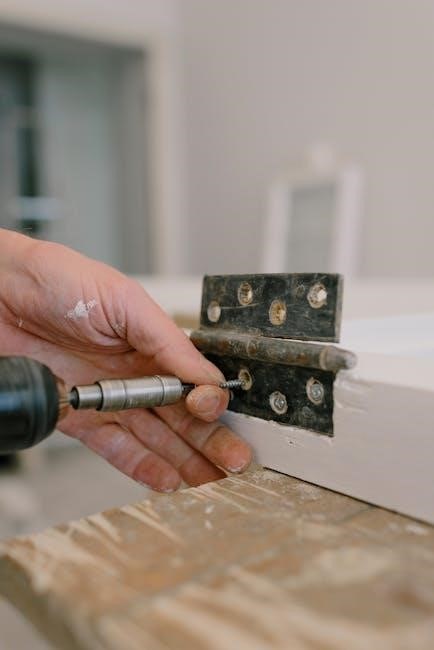
3.5 Setting Up Wi-Fi Connectivity
Connect the RJO101 to your home Wi-Fi network using the MyQ app. Download and install the app, then follow in-app instructions to link the opener to your router. Ensure your router is compatible with the opener’s Wi-Fi requirements. Once connected, the opener will be accessible via the app for remote operation and notifications. If issues arise, restart the router or reset the opener’s Wi-Fi settings. Verify connectivity by checking the LED status indicator, which should confirm a successful connection.
3.6 Final Adjustments and Testing
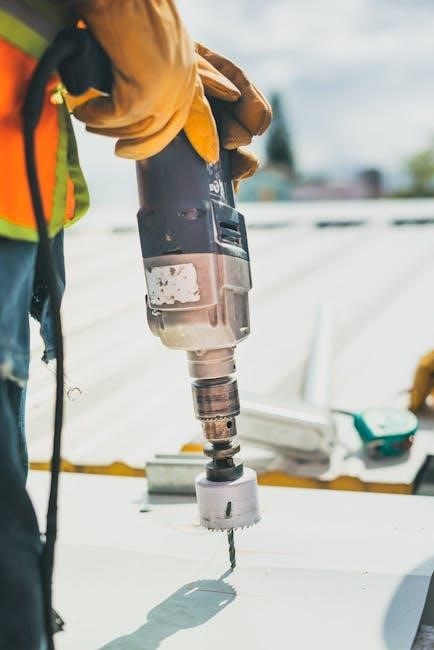
After installation, perform final adjustments to ensure smooth operation. Check all connections and tighten any loose fasteners. Test the opener by cycling the garage door open and closed, observing its movement. Adjust the force settings as needed to ensure proper operation. Verify that the safety reversal feature works correctly by placing an obstacle under the door during closure. Use the MyQ app to test remote functionality. If issues arise, consult the manual or reset the opener. Ensure all features function as expected before regular use.
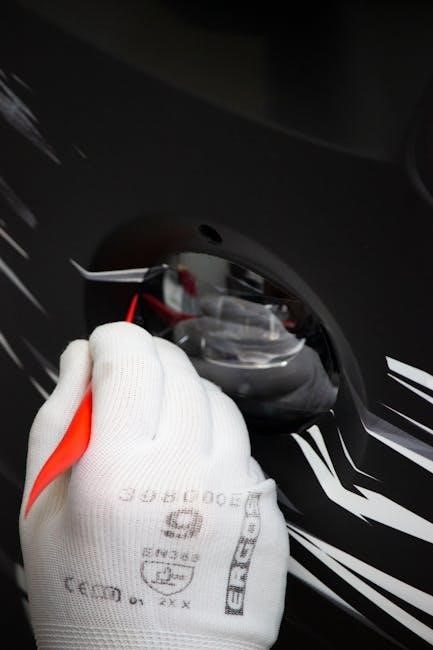
Post-Installation Checks
After installation, ensure the opener is properly aligned, all wires are secured, and safety features function correctly. Test the door’s smooth operation and adjust as needed.
4.1 Ensuring Proper Alignment
Proper alignment is critical for smooth operation. Check the torsion bar alignment with the opener’s attachment points. Verify the door is balanced and closes evenly. Use a spirit level to ensure the opener and door components are correctly aligned. Misalignment can cause uneven wear or noise. Adjust the opener’s mounting brackets if necessary. Cycle the door to test alignment accuracy. Ensure all safety sensors are properly aligned and functioning. Refer to the manual for specific adjustment instructions to achieve optimal performance and safety.
4.2 Testing the Opener’s Performance
After installation, cycle the door multiple times to ensure smooth operation. Check the opener’s speed and responsiveness. Verify that the door opens and closes fully, without hesitation or noise. Test safety features, such as automatic reversal, to ensure they function correctly. Use the BILT app for 3D instructions to confirm proper setup. Ensure Wi-Fi connectivity is stable for smart features. Perform manual and remote tests to assess performance consistency. Consult the manual for troubleshooting any issues during testing.
4.3 Securing Loose Wires and Components
Ensure all wires are tightly connected to their respective ports and terminals. Verify the battery backup (if installed) is securely fastened. Check that all screws, bolts, and brackets are tightened properly. Inspect the torsion bar connection for stability. Use cable ties to organize and secure loose wires. Confirm the opener’s mounting hardware is firmly attached to the wall. Refer to the BILT app for 3D guidance on securing components. Consult the manual for specific torque specifications and safety checks.
Troubleshooting Common Issues
Address error codes, connectivity issues, and noise concerns. Check wire connections, ensure proper alignment, and refer to the manual for specific solutions and diagnostic guidance.
5.1 Error Codes and Their Meanings

Understanding error codes is crucial for troubleshooting the RJO101. Common codes like E1, E2, and E3 indicate issues such as misalignment, sensor malfunctions, or connectivity problems. Refer to the manual for detailed explanations and solutions. For example, E1 may signal a misaligned safety sensor, while E2 could point to a wiring issue. Always check the user manual or the BILT app for 3D instructions to resolve errors effectively and ensure proper functionality.
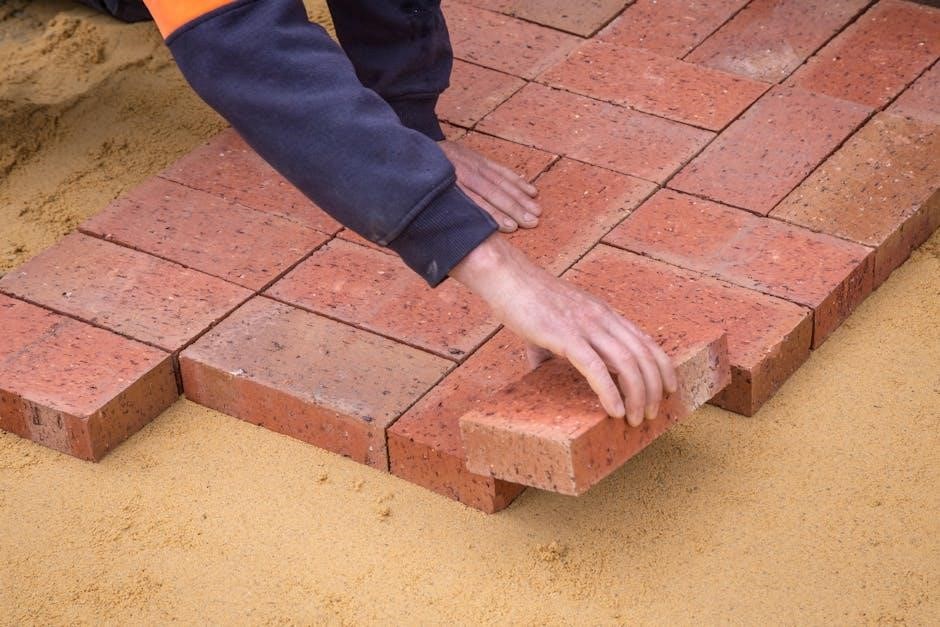
5.2 Resolving Connectivity Problems

Connectivity issues with the RJO101 can often be resolved by restarting the opener and router. Ensure the opener is connected to a stable 2.4 GHz Wi-Fi network. Check the Wi-Fi signal strength and move the router closer if necessary. If problems persist, reset the opener to factory settings and re-pair it through the myQ app. Always refer to the manual or BILT app for 3D guidance to restore connectivity and maintain smart functionality.
5.3 Addressing Noise or Vibration Concerns
To minimize noise and vibrations with the RJO101, ensure proper installation alignment and tighten all mounting hardware securely. Lubricate moving parts periodically to reduce friction. Check for loose components and adjust them as needed. Use the BILT app for 3D guidance to confirm correct assembly. If vibrations persist, consider adding anti-vibration pads or ensuring the torsion bar is balanced correctly. Refer to the manual for specific lubrication points and adjustment procedures to maintain smooth operation and reduce noise effectively. Regular maintenance is key to optimal performance and minimize disturbances.
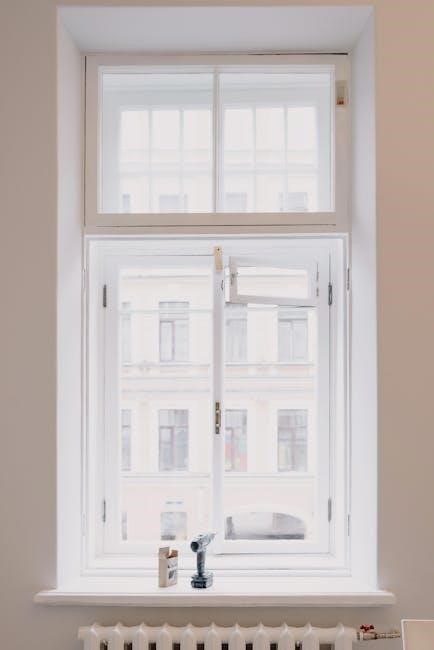
Maintenance and Care
Regular lubrication of moving parts and checking for loose components ensure smooth operation. Clean the opener periodically and verify proper alignment for optimal performance and longevity.
6.1 Routine Maintenance Tips
Regular maintenance ensures the Chamberlain RJO101 operates efficiently. Lubricate moving parts annually with a silicone-based spray. Check for loose screws or worn components and tighten or replace them as needed. Clean the opener’s exterior with a soft cloth to prevent dust buildup. Inspect the torsion spring and cables for signs of wear. Ensure the battery backup is fully charged and test it quarterly. Update the opener’s software periodically to maintain optimal performance and security. Always refer to the manual for detailed guidance on routine care.
6;2 Updating Firmware and Software
Regularly update the RJO101’s firmware and software to ensure optimal performance and security. Use the BILT app for 3D guidance or refer to the manual for step-by-step instructions. Check the Chamberlain website for the latest firmware version, download it, and follow the installation prompts. Restart the opener after updates to apply changes. Keeping the system updated prevents connectivity issues and enhances functionality; Always back up settings before performing updates to avoid configuration loss.
6.3 Cleaning and Lubricating Moving Parts
Regular cleaning and lubrication of the RJO101’s moving parts ensure smooth operation. Use a soft cloth to wipe down the torsion bar and opener components. Apply a silicone-based lubricant to hinges, rollers, and gears. Avoid using oil or grease, as they attract dust. Clean and lubricate every 3-6 months, depending on usage. Proper maintenance prevents wear and tear, ensuring the opener operates quietly and efficiently. Refer to the manual for detailed lubrication points and guidelines.
The Chamberlain RJO101 offers a reliable, space-saving solution with easy installation and maintenance, making it a top choice for modern garage door opener needs today.
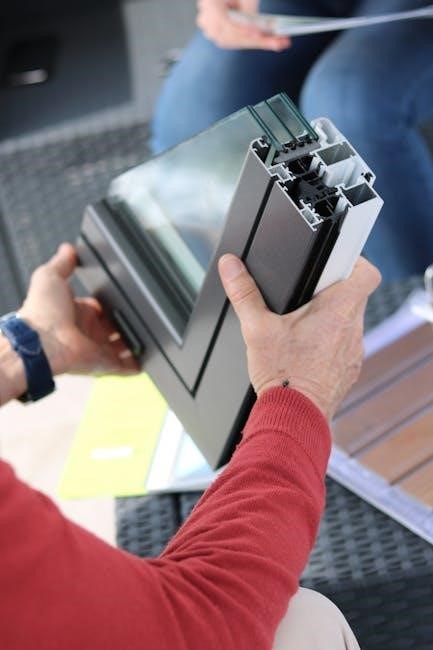
7.1 Final Thoughts on the RJO101 Installation
The Chamberlain RJO101 wall mount garage door opener stands out for its space-saving design and ultra-quiet operation, making it ideal for modern homes. Its Wi-Fi connectivity and smartphone integration enhance convenience, while the straightforward installation process, supported by 3D instructions via the BILT app, ensures a hassle-free setup. With a limited lifetime warranty on the motor and belt, this model offers both reliability and long-term value, making it a top choice for homeowners seeking efficiency and durability in their garage door opener.
7.2 Resources for Further Assistance
For additional support with the Chamberlain RJO101 installation, refer to the official installation manual available on Chamberlain’s website. The BILT app provides interactive 3D instructions for a seamless setup experience. Contact Chamberlain’s customer support via phone or email for personalized assistance. You can also visit their official website for troubleshooting guides, FAQs, and software updates. For community support, join forums or social media groups dedicated to Chamberlain products to share experiences and solutions with other users.